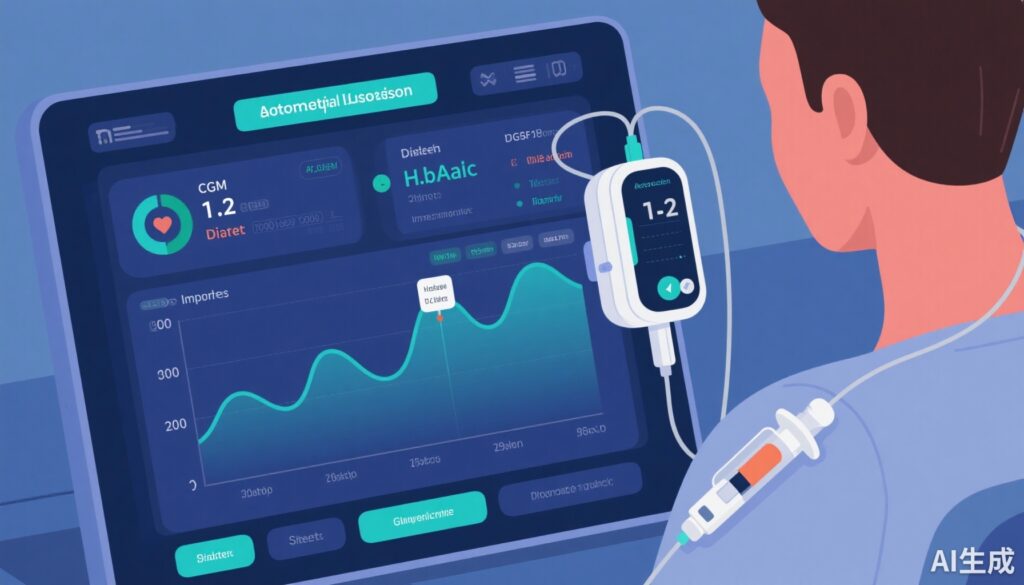Highlights
- Automated insulin delivery (AID) systems significantly improve glycemic control in insulin-treated type 2 diabetes patients compared to conventional insulin delivery combined with continuous glucose monitoring (CGM).
- Randomized controlled trials demonstrate notable HbA1c reductions (~0.6–0.8%) and marked increases in time-in-range (TIR) without increased hypoglycemia risk.
- Longer-term extension studies indicate sustained glycemic benefits and safety, supporting the integration of AID systems in type 2 diabetes management.
- Incorporation of patient-centered digital tools and shared decision-making may further optimize therapy adherence and outcomes.
Background
Type 2 diabetes mellitus (T2DM) affects millions worldwide, with a substantial proportion requiring insulin therapy due to progressive beta-cell failure and worsened glycemic control. Effective and safe insulin delivery is essential to mitigate hyperglycemia-related complications. While automated insulin delivery (AID) systems have revolutionized type 1 diabetes management by combining insulin pumps with real-time CGM and algorithm-driven dosing adjustments, their role in insulin-treated T2DM has remained less defined. Given the distinct insulin resistance and beta-cell dysfunction in T2DM, along with a typically older and more heterogeneous patient population, robust clinical evidence from randomized controlled trials (RCTs) is crucial to guide adoption. This review synthesizes the current RCT evidence on AID use in insulin-treated T2DM and integrates complementary research highlighting lifestyle interventions and digital tools that intersect with technology-driven insulin management.
Key Content
Randomized Controlled Trials of AID in Insulin-Treated Type 2 Diabetes
A multicenter, randomized, controlled 13-week trial by Kudva et al. (NEJM, 2025) enrolled 319 insulin-treated adult T2DM patients randomized 2:1 to AID versus control groups, both using CGM. The AID arm demonstrated a mean HbA1c decline of 0.9 percentage points (from baseline 8.2% to 7.3%) versus 0.3 percentage points in controls (from 8.1% to 7.7%), yielding a statistically significant mean adjusted difference of -0.6 percentage points (95% CI, -0.8 to -0.4; P<0.001). The percentage time in glycemic target range (70–180 mg/dL) increased by 16 percentage points in the AID group (from 48% to 64%) compared with 1 percentage point in controls (51% to 52%; P<0.001). All hyperglycemia-related CGM metrics favored AID, while hypoglycemia rates remained low without significant between-group differences. These findings underscore the potential of AID to enhance glycemic outcomes safely in this population.
A complementary single-arm, prospective trial (JAMA Netw Open, 2025) evaluating the Omnipod 5 AID system in 305 diverse insulin-treated T2DM adults corroborated these results, with a mean HbA1c reduction of 0.8% over 13 weeks. This study included a substantial proportion of racial and ethnic minorities, users of multiple daily injections (MDI), basal-only insulin, and concurrent antidiabetic agents (GLP-1 receptor agonists and SGLT-2 inhibitors), demonstrating consistent efficacy across subgroups. TIR improved by 20 percentage points without increases in hypoglycemic episodes or diabetic ketoacidosis, supporting AID’s safety and broad applicability.
Longer-term data from an 8-week initial trial with a 26-week extension phase (Diabetes Obes Metab, 2025) evaluating Omnipod 5 reported sustained HbA1c reductions (mean decrease 1.6%) and increased TIR by over 22%, highlighting the durability of AID benefits. Importantly, total daily insulin dosage and body mass index remained stable, indicating efficiency without weight gain or increased hypoglycemia.
Role of Continuous Glucose Monitoring and Lifestyle Interventions
Interventional studies emphasize the additive value of CGM in non–insulin-dependent T2DM patients improving glycemic metrics through empowered food and lifestyle choices (Diabetes Technol Ther, 2025). These findings suggest that CGM, a critical component of AID systems, may independently promote behavior modification. A data-driven understanding of T2DM heterogeneity using innovative phenotype mapping (Diabetes, 2025) reveals differential responses to dietary versus exercise interventions, informing personalized management that can integrate with AID technology to optimize outcomes.
Digital Health and Clinical Decision Support Integration
Innovations in digital clinical decision support and individualized lifestyle coaching (Nutrients, 2025) have been evaluated in cluster-randomized trials showing promising effects on cardiovascular risk factors among T2DM patients. Such tools offer potential complementary strategies to enhance pharmacologic diabetes care, and their integration with AID systems could personalize insulin titration and lifestyle management synergistically.
Expert Commentary
The accumulating RCT evidence firmly positions AID as a viable, effective, and safe modality for insulin-treated T2DM. Unlike T1DM, T2DM poses unique challenges due to its heterogeneity and often older patient demographics. The demonstrated HbA1c reductions (~0.6–0.8%) and TIR improvements (>14–20 percentage points) in RCTs are clinically meaningful and align with reductions shown to impact microvascular outcomes. The low incidence of hypoglycemia observed is notable given concerns about intensified insulin regimens in this population.
Potential limitations include relatively short trial durations, which necessitate further research into long-term efficacy, adherence, and safety, especially in real-world diverse clinical settings. Furthermore, cost-effectiveness analyses and health equity considerations are crucial, as socioeconomic disparities can affect access and uptake of diabetes technologies.
Mechanistically, AID systems capitalize on closed-loop algorithms that adjust basal insulin delivery in real time based on CGM readings, reducing glucose variability and hyperglycemia duration. This technology complements the advances in pharmacotherapy (e.g., GLP-1RAs, SGLT-2is) and lifestyle modifications. The future of T2DM management may involve integrative models combining AID systems, digital health coaching, shared decision-making aids, and anti-inflammatory nutritional strategies (e.g., omega-3 fatty acids) to target multifaceted pathophysiology.
Conclusion
Recent high-quality randomized trials provide compelling evidence that automated insulin delivery systems significantly improve glycemic control in adults with insulin-treated type 2 diabetes, reducing HbA1c and increasing time spent in target glucose ranges without increasing hypoglycemia risk. Sustained benefits over longer durations further support their clinical utility. Emerging data also suggest that integration of AID with tailored lifestyle interventions and digital decision supports may optimize individualized diabetes management. Future research should focus on real-world implementation, cost-effectiveness, equity in access, and long-term outcomes including complications reduction.
References
- Kudva YC, Raghinaru D, Lum JW, et al; 2IQP Study Group. A Randomized Trial of Automated Insulin Delivery in Type 2 Diabetes. N Engl J Med. 2025 May 8;392(18):1801-1812. doi:10.1056/NEJMoa2415948. PMID: 40105270.
- Zisser H, Michaels J, Lum JW, et al. Glycaemic outcomes in adults with type 2 diabetes over 34 weeks with the Omnipod® 5 Automated Insulin Delivery System. Diabetes Obes Metab. 2025 Jan;27(1):143-154. doi:10.1111/dom.15993. PMID: 39382001.
- Bergenstal RM, Klonoff DC, Garg SK, et al. Automated Insulin Delivery in Adults With Type 2 Diabetes: A Nonrandomized Clinical Trial. JAMA Netw Open. 2025 Feb 3;8(2):e2459348. doi:10.1001/jamanetworkopen.2024.59348. PMID: 39951268.
- Miller KM, McCall A, Shah VN, et al. A Randomized Controlled Trial Using Continuous Glucose Monitoring to Guide Food Choices and Diabetes Self-Care in People with Type 2 Diabetes not Taking Insulin. Diabetes Technol Ther. 2025 Apr;27(4):261-270. doi:10.1089/dia.2024.0579. PMID: 39757879.
- Xie H, Berndt S, Jiang X, et al. Heterogeneity in Phenotype and Early Metabolic Response to Lifestyle Interventions in Type 2 Diabetes in China Using a Tree-Like Representation. Diabetes. 2025 Sep 4:db250197. doi:10.2337/db25-0197. PMID: 40906542.
- Ebert B, Westergaard M, Bøgelund M, et al. Protocol for the Digital, Individualized, and Collaborative Treatment of Type 2 Diabetes in General Practice Based on Decision Aid (DICTA)-A Randomized Controlled Trial. Nutrients. 2025 Jul 30;17(15):2494. doi:10.3390/nu17152494. PMID: 40806079.


